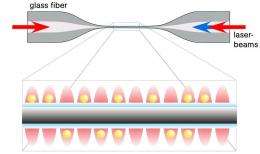German physicists develop a quantum interface between light and atoms

German hysicists at the Johannes Gutenberg University Mainz have developed a quantum interface which connects light particles and atoms.
The interface is based on an ultra-thin glass fiber and is suitable for the transmission of quantum information. This is an essential prerequisite for quantum communication which shall be used for secure data transmission via quantum cryptography. "Our quantum interface might also prove useful for the realization of a quantum computer," adds Professor Dr Arno Rauschenbeutel from the Institute of Physics at Mainz University.
Today, telephone and internet primarily rely on the optical transmission of data using glass fiber cables. In that sense, glass fiber networks can be considered as the backbone of the modern communication society. The light that travels through them is not a continuous flow of energy. It rather consists, as was discovered by Albert Einstein, of indivisible energy quanta, or photons. Each photon can then transmit one bit of information, corresponding to a zero or one.
In addition to being very efficient, this also opens the route towards entirely new ways of communication because, being quantum objects, photons can exist simultaneously in both states, zero and one. As an example, this property is what makes quantum cryptography possible and thereby enables absolute protection against eavesdropping.
In order to fully exploit the potential of quantum communication, however, one additionally needs the possibility to store the quantum information that is encoded on each photon. Photons themselves are not well suited for this purpose because one cannot hold them at a given position. Therefore, it would be much more advantageous to transfer the quantum information to atoms. For this purpose one thus requires a quantum interface between photons and atoms which should ideally be easily integrated into glass fiber networks.
A group of physicists led by Professor Arno Rauschenbeutel has now realized such a glass fiber-based quantum interface. As reported by the research team in the current issue of the scientific journal Physical Review Letters, the central part of the work in Mainz is a glass fiber which has been heated and stretched until it measures only one hundredth of the diameter of a human hair.
Remarkably, this nanofiber is thinner than the wavelength of the light it guides. As a consequence, the light is no longer restricted to the inside of the nanofiber but laterally protrudes into the space surrounding the fiber. Using this so-called evanescent field, the scientists trapped cesium atoms after they have been cooled to a few millionth of a degree above absolute zero by irradiation with suitably chosen laser light. When trapped, the atoms are arranged in a regular pattern and are levitated 200 nm above the surface of the nanofiber.
This distance might seem very small but it indeed is big enough to protect the atoms from the spurious influences of the fiber surface. At the same time, the atoms reside in the evanescent field and thus interact with the photons propagating through the nanofiber.
As was demonstrated by the researchers, this process is so efficient that only a couple of thousand atoms should suffice for a close to lossless transfer of quantum information between photons and atoms. Further possible applications of the Mainz quantum interface include the connection of different quantum systems. As an example, the trapped atoms could be brought into close vicinity of a superconducting quantum circuit in order to combine the advantageous properties of both systems. This would then be an important step towards the realization of a quantum computer.
More information: E. Vetsch, D. Reitz, G. Sagué, R. Schmidt, S. T. Dawkins, and A. Rauschenbeutel, Optical interface created by laser-cooled atoms trapped in the evanescent field surround-ing an optical nanofiber, Physical Review Letters, May 21, 2010, DOI:10.1103/PhysRevLett.104.203603
Provided by Mainz University

















